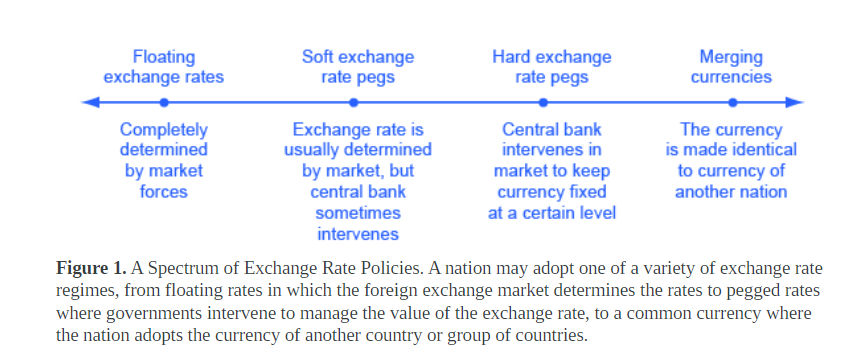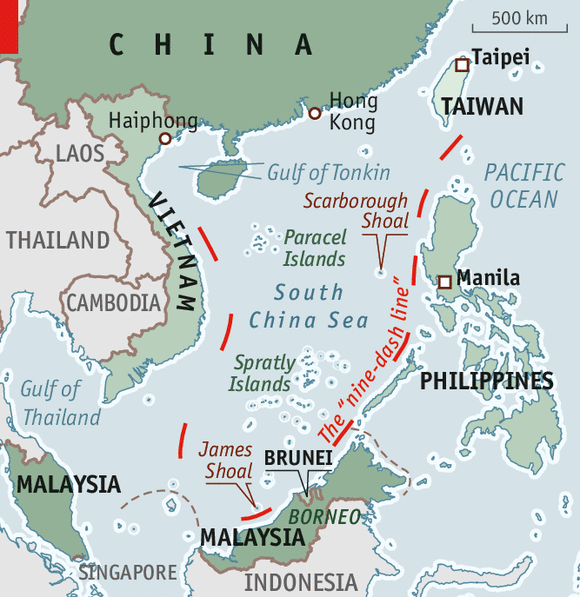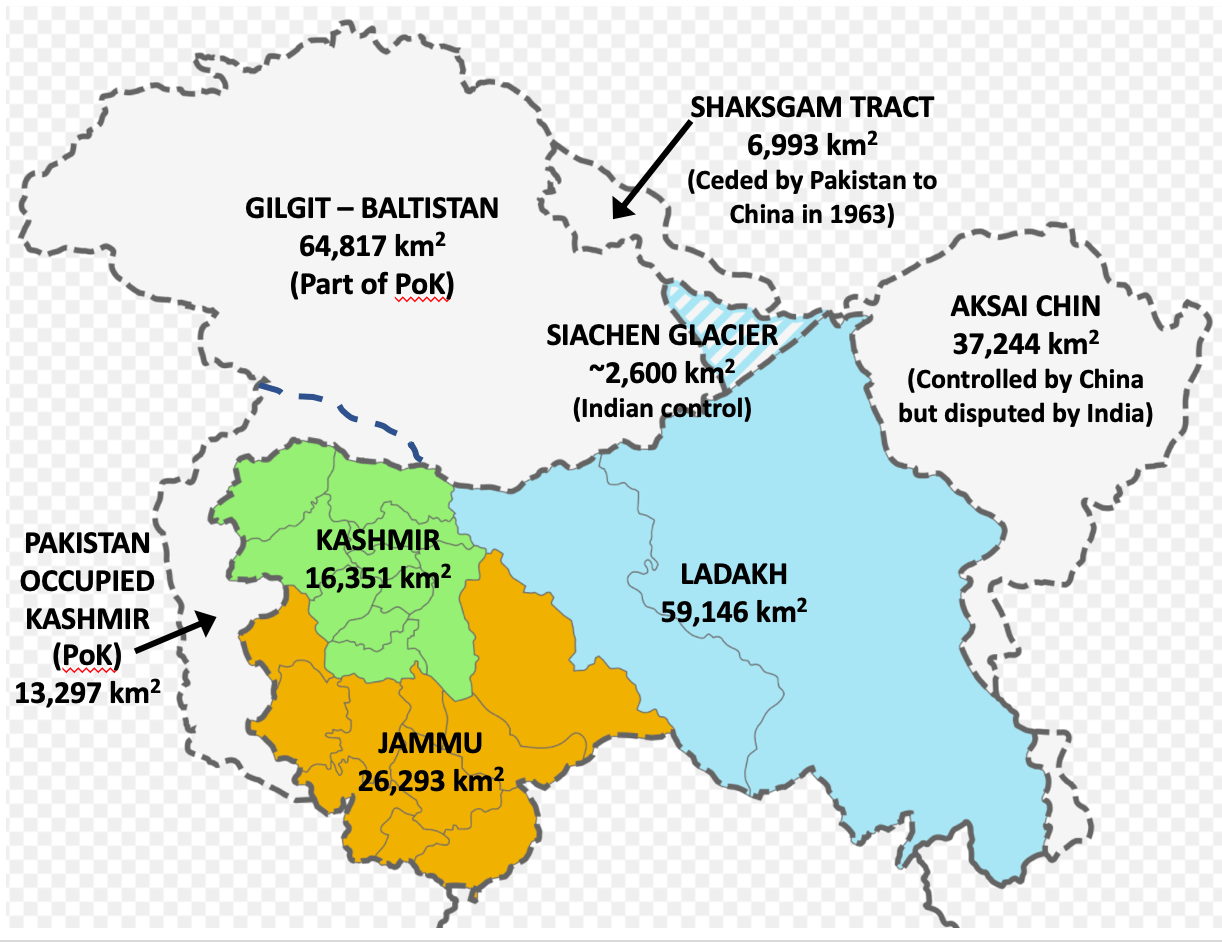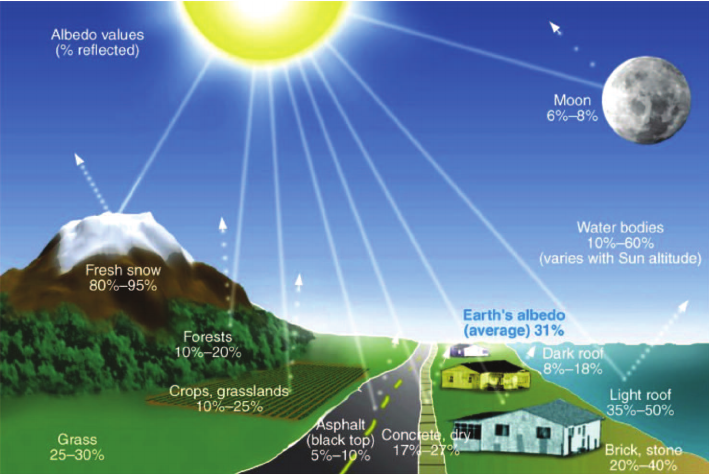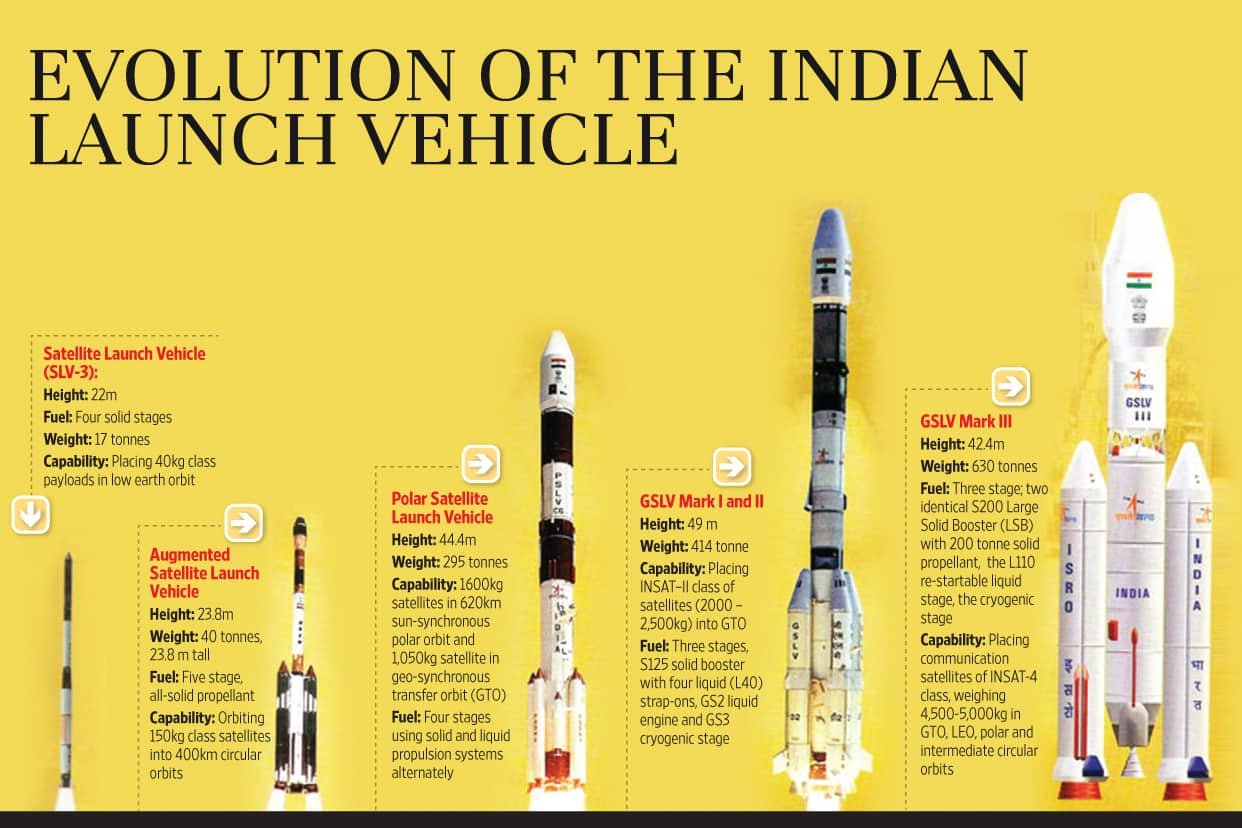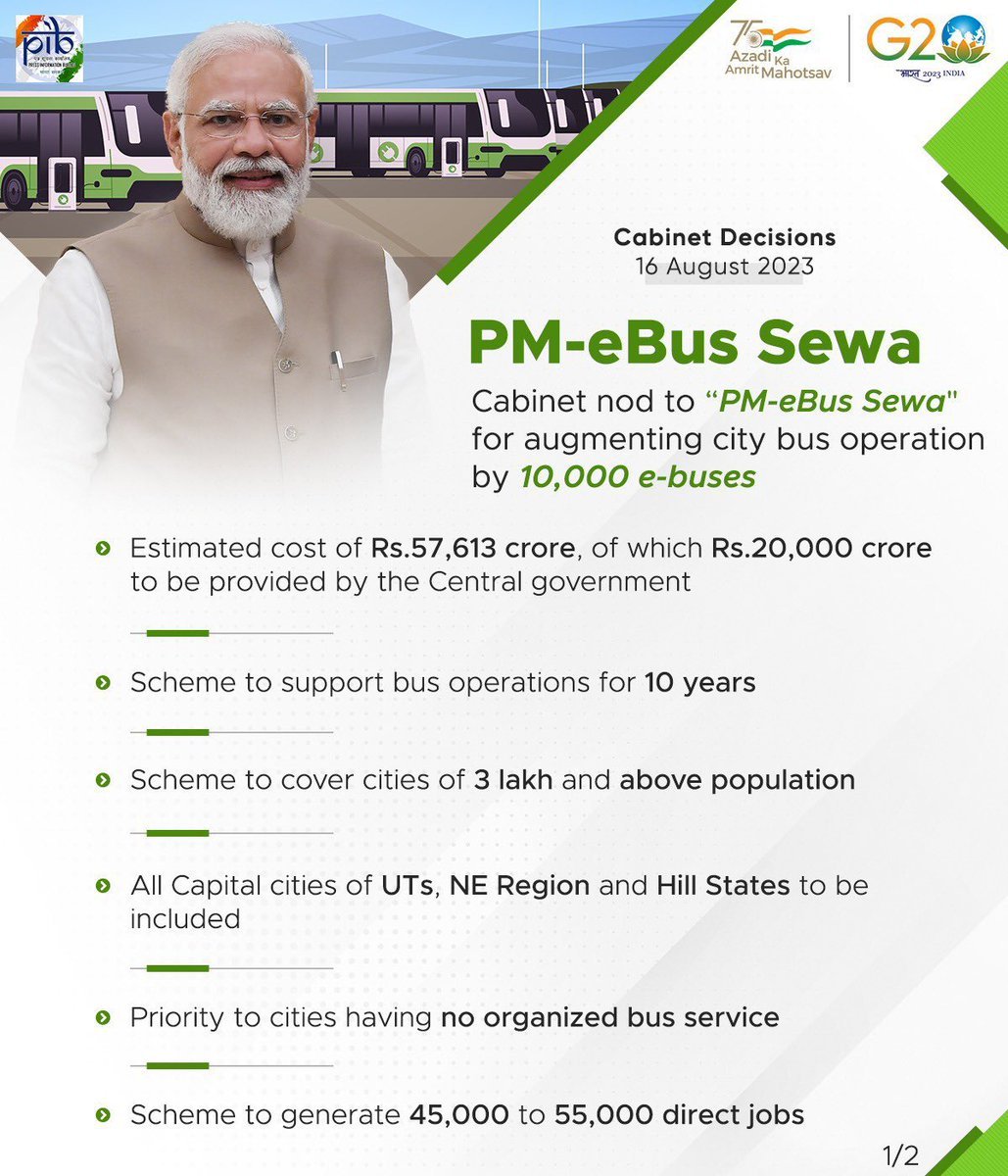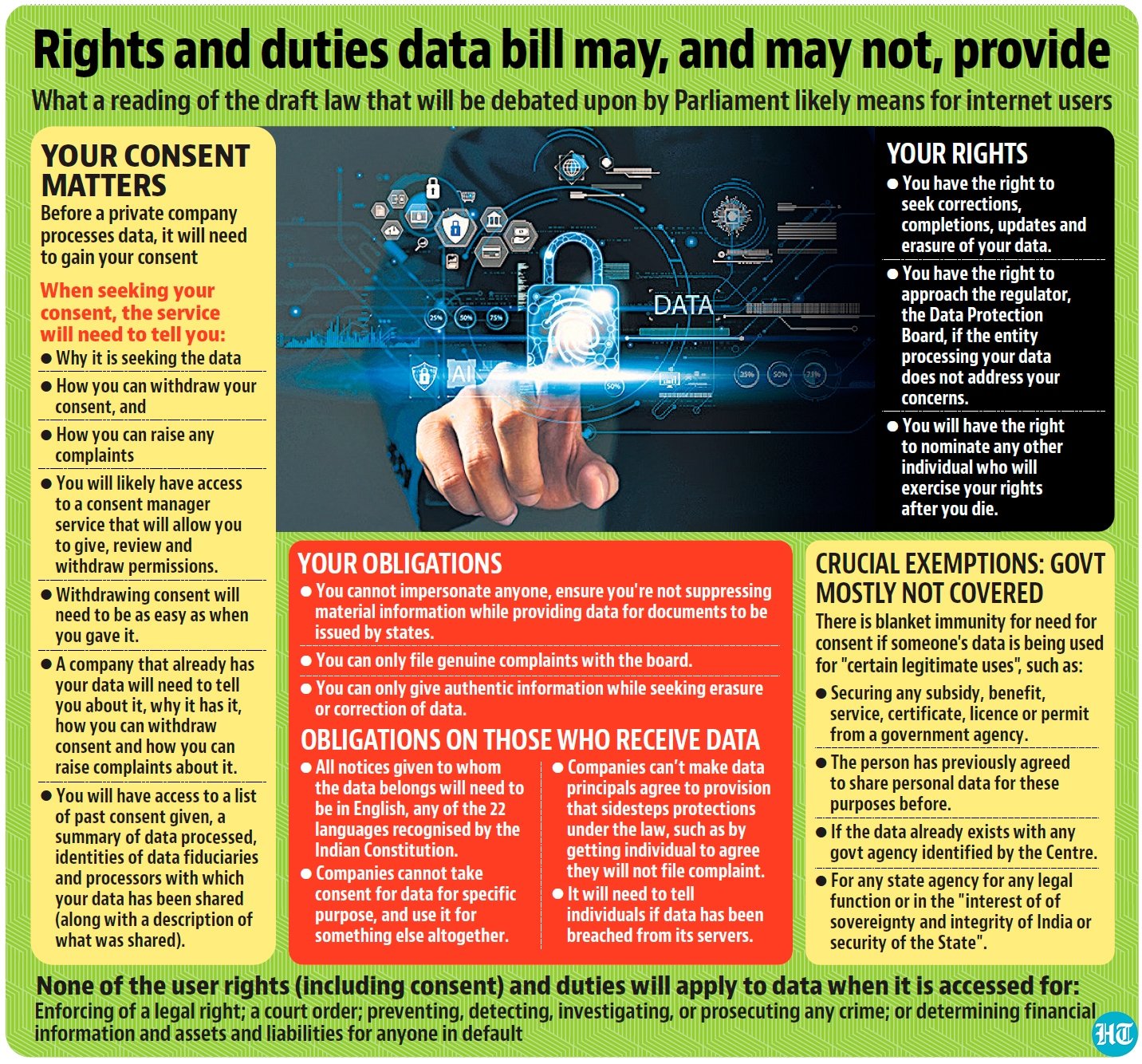
Current Affairs for UPSC Civil Services Exam – April 24, 2024
Subscribers of "Current Affairs" course can Download Daily Current Affairs in PDF/DOC
Subscribe to Never Miss an Important Update! Assured Discounts on New Products!
Must Join PMF IAS Telegram Channel & PMF IAS History Telegram Channel
{GS2 – Polity – IC – FRs} Freedom of the press vs. Right to Reputation
- Context (IE): Bombay HC directed a journalist to take down social media posts that were found “defamatory” after a businessman filed a defamation suit against the journalist.
Court’s Observation
- The freedom of the press, which is being evolved as a species of speech, will definitely have to be balanced against an individual’s right to his reputation.
- Investigative journalism does not enjoy special protection, and the public interest doesn’t justify publishing content that harms someone’s reputation.
What does the term “Press Freedom” mean?
- Press freedom is a fundamental principle that allows journalists and media organisations to operate without censorship or government interference.
- It is a core component of freedom of expression and is essential for a democratic society.
Constitutional Background
- Freedom of the Press is nowhere mentioned in the Constitution.
- However, Freedom of the press or media refers to the rights given by the IC under the freedom and expression of speech in Article 19(1)(a).
- It encourages independent journalism and promotes democracy by letting the people voice their opinions for or against the government’s actions.
- However, there are certain restrictions in Article 19(2) to protect the nation and its integrity.
Press freedom encompasses the following key aspects.
- Freedom from Censorship: Journalists and media outlets should be able to publish or broadcast news and information without government-imposed censorship.
- Access to Information: A free press should have access to information and sources to investigate and report on matters of public interest.
- Independence: Editorial independence ensures that news reporting is based on facts and not influenced by outside interests.
- Protection of Sources: Journalists should be able to protect their sources to encourage whistleblowers and informants to come forward with information without fear of exposure or reprisal.
- Pluralism and Diversity: A free press should encompass a diverse range of viewpoints and opinions, allowing for open debate and discussion in society.
- Accountability: The media should hold those in power accountable by investigating and reporting on their actions and decisions.
Why is freedom of the press critical in India?
- Free exchange of ideas: The press inspires people to think beyond social norms and gives a platform to exchange ideas and thoughts that deserve to be heard by people all around the nation.
- Holding the person or body accountable for their actions: Often, people try to cover up their actions and settle a case without involving the media. The press exposes such situations and ensures that justice is served correctly with the backing of the common people.
- Voice of the people: The press acts as a channel that writes and speaks the thoughts of the people.
- It focuses on the issues that are suppressed and brings forward the ones that should be talked about.
- Fourth pillar of democracy: Since the media is an independent body that challenges the Government, it can be referred to as the fourth pillar of democracy alongside the judiciary, legislative and executive.
Institutions Responsible for Protecting Press Freedom in India
- Press Council of India (PCI): It is a statutory body established under the Press Council Act of 1978.
- Watchdog to safeguard and promote press freedom and the ethical standards of journalism.
- Ministry of Information and Broadcasting: This government body formulates policies and guidelines related to the media sector in India.
- News Broadcasters Association (NBA): NBA is a self-regulatory body representing the private television news and current affairs broadcasters in India.
- It formulates and enforces a code of ethics and standards for television news channels.
- Editors Guild of India: It is a voluntary association of editors of leading newspapers and news magazines in India.
- Legal System: India’s legal system, including the judiciary, plays a significant role in upholding press freedom.
- Courts have the authority to address violations of press freedom, protect journalists, and interpret laws related to media.
- In 1950, the SC in Romesh Thappar v. The State of Madras observed that freedom of the press lay at the foundation of all democratic organisations.
- International Organizations: International organisations such as Reporters Without Borders (RSF) and the Committee to Protect Journalists (CPJ) monitor press freedom in India and raise awareness about violations on the global stage.
{GS3 – IE – RBI} Effective Exchange Rate (EER)
- Context (IE): The last 10 years have seen the Indian currency fall more against the dollar than during the previous 10 years.
- Since April-end 2014, the rupee has depreciated by 27.6% against the US dollar. However, the rupee strengthened in real terms when its exchange rate with all major global currencies was taken.
Effective Exchange Rate (EER)
- The rupee’s strength or weakness depends on its exchange rate with the US dollar and other global currencies. This includes a basket of currencies from India’s major trading partners, known as the rupee’s effective exchange rate or EER.
- The Effective Exchange Rate (EER) is measured using an index similar to the Consumer Price Index (CPI).
- The CPI calculates the average retail price of a standard consumer basket of goods and services for a specific period compared to a fixed base period.
- Similarly, the EER measures the weighted average of the rupee’s exchange rates against the currencies of India’s major trading partners.
- Currency weights in the EER are determined by each country’s share in India’s total foreign trade.
- There are two measures of Effective Exchange Rate (EER).
- Nominal EER or NEER.
- Real Effective Exchange Rate (REER).
Nominal EER or NEER
- RBI has developed NEER indices for the rupee against two baskets of currencies.
- One basket has six currencies: US dollar, euro, Chinese yuan, British pound, Japanese yen, and Hong Kong dollar.
- The other NEER index covers a larger basket of 40 currencies, representing countries contributing to about 88% of India’s annual trade.
- NEER indices are calculated based on a reference base year value of 100 for 2015-16.
|
Real Effective Exchange Rate (REER)
- While the Nominal Effective Exchange Rate (NEER) reflects movements in the rupee’s external value against a basket of currencies, it doesn’t consider inflation, which affects the rupee’s internal value.
- For example, the Indonesian rupiah has fallen by 8.5% against the US dollar in the past year, while the Indian rupee depreciated by only 1.7%.
- However, India’s March annual CPI inflation rate of 4.9% was higher than Indonesia’s 3.1%.
- This means the Indonesian currency’s domestic purchasing power suffered less erosion compared to its international purchasing power, while it was the opposite for the rupee.
- REER adjusts the NEER for inflation differentials between the home country and its trading partners.
|
Analysis of the last 10 years
The rupee weakened less relative to other currencies
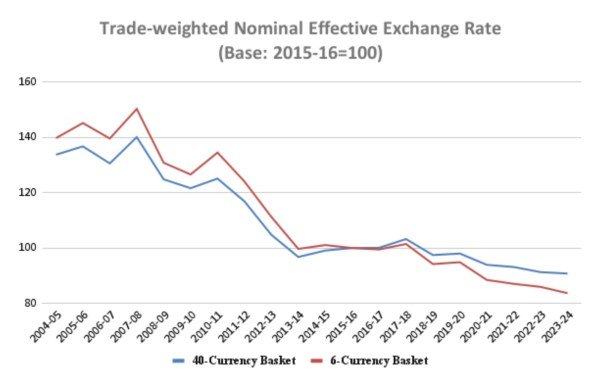
- The NEER against the 40-currency basket decreased by approximately 32.2% from 2004-05 to 2023-24, falling from 133.8 to 90.8.
- The decline was even steeper for the narrower 6-currency basket NEER, around 40.2%, from 139.8 to 83.7 during the same period.
- Meanwhile, the rupee’s average exchange rate against the US dollar decreased by 45.7%, from Rs 44.9 to Rs 82.8.
The rupee has strengthened in real terms
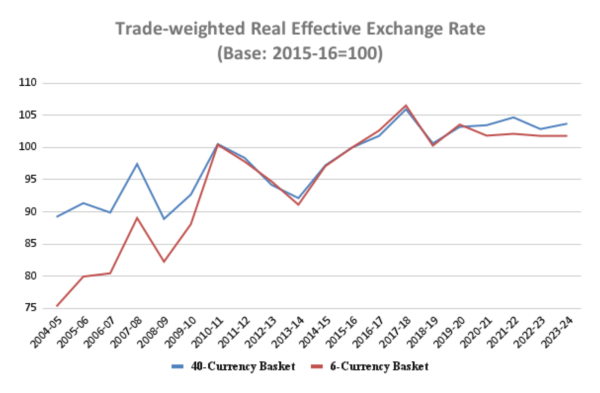
- During 9 out of the 10 years from 2014 to 2024, the rupee’s REER has been at 100 or above.
- This trend contrasts with the weakening trend observed when considering only the rupee’s Nominal Effective Exchange Rate (NEER) or its exchange rate against the US dollar.
{GS3 – IE – Inequality} Findings of World Inequality Lab Report
- Context (TH): In March, the World Inequality Lab released a working paper titled Income and Wealth Inequality in India, 1922-2023: The Rise of the Billionaire Raj.
Key findings
Income Inequality
- By 2022-23, the top 1% of the population earned 22.6% of India’s national income, the highest percentage in a century.
- The top 0.1% of the population earned nearly 10% of the national income.
- India’s top 1% share of national income is among the highest globally.
Wealth Inequality
- In 2022-23, the top 1% of the population owned 40.1% of the country’s wealth, the highest level since 1961.
- The share of wealth among the top 10% increased from 45% in 1961 to 65% in 2022-23.
- Conversely, the share of wealth held by the bottom 50% and middle 40% declined.
- The disparity is evident, with approximately 10,000 individuals out of 92 million Indian adults owning an average of ₹22.6 billion in wealth, which is 16,763 times the average Indian’s wealth.
Impacts of Inequality: A comparison with China
- Income and wealth inequality are closely tied to economic growth and human development.
- Until 1975, India’s average income, adjusted for inflation and purchasing power, was similar to that of China and Vietnam. However, in the next 25 years, incomes in China and Vietnam grew by 35-50% more than those in India.
- Post-2000, China’s income surged significantly and became 2.5 times that of India’s income.
- Despite rapid growth, China’s economy maintained a more evenly distributed growth compared to India. In 2022, the top 1% in India earned nearly 50% more income than their counterparts in China.
- China has sustained higher economic growth with moderate economic inequality, while India’s growth has been moderate alongside extreme economic inequality.
How to reduce inequality?
- Achieving high economic growth and reducing inequality requires improvements in human development and poverty reduction, as seen in China and Vietnam.
- Sustainable economic growth depends on prior improvements in human development.
- States like Kerala, Tamil Nadu, Andhra Pradesh, Karnataka, Maharashtra, Gujarat, Punjab, and Delhi sustained high growth rates over three decades due to relatively advanced human development.
- Conversely, states like Jharkhand, Chhattisgarh, Bihar, Madhya Pradesh, Odisha, Uttar Pradesh, and Rajasthan, which are relatively backward in the Human Development Index, registered growth rates of less than 5% per annum post-liberalization.
Concerns
- Economic growth in India has not led to a corresponding growth in human development.
- The Human Development Report (HDR) 2023-2024 ranked India 134 out of 193 countries.
- Despite being the fifth largest economy, India ranks lower than Sri Lanka, Bhutan, and Bangladesh in human development.
- India’s HDR score decreases by 31.1% when accounting for economic inequality.
Way forward
- Human development should be prioritised for inclusive growth rather than waiting for benefits to trickle down to the poor.
- Economic growth cannot be inclusive and will worsen inequality without improvements in human development, capability, functioning, and poverty reduction.
{GS3 – Envi – Conservation} NABARD Climate Strategy 2030
- Context (TH): On Earth Day, the National Bank for Agriculture and Rural Development (NABARD) unveiled its Climate Strategy 2030 document, which aims to address India’s need for green financing.
- Key strategy pillars: Accelerating green lending across sectors, Broadening the market-making role, Internal green transformation, and Strategic resource mobilisation.
India’s need for green financing
- India requires approx. $170 billion annually to reach a cumulative total of over $2.5 trillion by 2030.
- As of 2019-20, India garnered only about $49 billion in green financing.
- The majority focused on mitigation; only $5 billion was allocated towards adaptation and resilience.
- Minimal private sector engagement in adaptation and resilience due to challenges in bankability and commercial viability was observed.
Sustainable practices examples from the Private sector
- DLF: The only Indian real estate company featured in the Dow Jones Sustainability Index in the last three years. It is committed to water reduction & reuse and transplanting of mature trees.
- Signature Group: EDGE-certified or IGBC gold-rated projects and reduced water usage by low-flow water faucets and toilets, rainwater collecting systems, and wastewater treatment and reuse facilities.
- Remsons Industries: Received the Gold Medal in the Ecovadis Sustainability Assessment by showcasing exemplary performance in key areas such as Environment and Sustainable Procurement.
Indian Green Building Council (IGBC)
|
|
|
{GS3 – Envi – Plastic Pollution} Plastic Treaty
- Context (IE | IE | DTE | DTE | DTE | DTE): Global leaders will gather in Ottawa, Canada, to discuss progress in drafting a first-ever global treaty to rein in soaring plastic pollution by the year-end.
Intergovernmental Negotiating Committee (INC)
|
Why are we having Plastic Treaty Talks?
- At the U.N. Environmental Assembly in 2022, a resolution to ‘End Plastic Pollution: Towards an International Legally Binding Instrument’ was adopted.
- The world’s nations agreed to develop a legally binding agreement by the end of 2024 to address it.
- The treaty is meant to address plastics throughout their lifecycle — from production to disposal.
Challenge in Ottawa
- Countries have become divided on the issues during three previous rounds of talks, held in Punta del Este, Uruguay, Paris, and most recently, Nairobi.
What do countries want in the treaty?
- Many plastic and petrochemical-producing countries, including Saudi Arabia, Iran and China – known collectively as the group of Like-Minded Countries – have opposed mentioning production limits.
- They blocked other countries from formally working on proposed treaty language calling for production caps, chemical disclosures or reduction schedules after the Nairobi session.
- Meanwhile, the 60-nation “High-Ambition Coalition”, which includes EU countries, island nations and Japan, wants to end plastic pollution by 2040.
- This coalition has called for common, legally binding provisions to “restrain and reduce the production and consumption of primary plastic polymers to sustainable levels.”
- They also are proposing measures such as phasing out “problematic” single-use plastics and banning certain chemical additives that could carry health risks.
What does the Petrochemical Industry want?
- The trade group Global Partners for Plastics Circularity represents major petrochemical producers, including members of the American Chemistry Council and Plastics Europe.
- The group argues that production caps would raise consumer prices and that the treaty should address plastics only after they are made.
- These companies want to focus on encouraging the reuse or recycling of plastics, including deploying technology that can turn plastic into fuel.
- In terms of transparency about chemicals used in production, the group says companies should be allowed to disclose those chemicals voluntarily.
What do Corporate Brands want?
- More than 200 consumer-facing companies, including Unilever, PepsiCo and Walmart, have joined the so-called Business Coalition for a Plastics Treaty.
- They support a treaty that includes production caps, use “restrictions and phase-outs, reuse policies, product design requirements, extended producer responsibility, and waste management.”
What does Civil Society want?
- The Global Alliance for Incinerator Alternatives (GAIA) Asia Pacific has called on the Association of Southeast Asian Nations (ASEAN) to take decisive action against plastic pollution.
- The CSOs advocated for a robust international treaty that includes legally binding obligations on governments to reduce plastic production and consumption.
- They also called for focusing on the entire plastic lifecycle, emphasising that an effective agreement should address all its stages.
How do countries intend to tackle existing plastic pollution?
- EU added terrestrial and freshwater sources to be prioritised for identification & other interventions.
- Australia focused on the collection of data regarding existing pollution to enhance monitoring.
- Iran highlighted the role of developed countries and their historical responsibility for existing plastic pollution, while Russia expressed its desire to focus only on legacy plastic pollution.
- The USA did not agree to identify problematic sectors contributing to existing plastic pollution or to harmonise indicators to identify accumulation zones, hotspots, and sectors.
- India proposed forming a subsidiary body to assess each country’s current levels of plastic pollution and the financial resources required to mitigate and remediate it.
Views of Various Countries on Plastic Waste Management
- The European Union, Pacific Small Island Developing States (PSIDS) and the African group agreed to most of the provisions for facilitating environmentally sound management of plastic waste, including through collection, recycling and disposal rates as per the waste hierarchy.
- The African group also proposed that the plastic producer be responsible for managing plastic waste.
- The United States suggested identifying and strengthening the market for secondary plastics.
- Brazil disagreed with the minimum collection, recycling and disposal rates for plastic waste.
- India, Iran, and Japan view that plastic waste management activities may not necessarily follow the order of priority, and preference may be given to disposal and/or energy recovery, challenging the theory of environmentally sound waste management.
Status of Extended Producer Responsibility (EPR) globally
- There is no consensus on a harmonised global EPR; the EU is the only region to propose an EPR to incentivise “plastic reduction and reuse” in addition to high-quality recycling.
- Africa has requested for intersessional work on this issue and the Pacific Small Island Developing States (PSIDS) have suggested that the governing body would adopt the modalities in the subsequent sessions.
- Japan and Norway have advocated for a sector-specific EPR.
- The United States and India have demanded a national approach. The US, though, has disagreed with placing accountability on producers.
- Both India and the US have removed strong language like “across life cycles and international supply chains”. China has recommended that this provision be merged with the one on waste management.
- Some countries, like the US, Iran, and Russia, have also advocated for non-fiscal EPR, thus weakening the whole idea of producer responsibility, in which the polluter walks free from the burden of basic activities like collection and recycling.
Countries on promotion and adoption of non-plastic substitutes
- Non-plastic substitutes include renewable materials like plant fibres, cellulose, starches & agricultural byproducts, which can be sustainably sourced and may biodegrade more readily.
- By incentivising the adoption of non-plastic substitutes, stakeholders aim to foster innovation, resource efficiency and environmental stewardship in material selection and product design.
- The European Union (EU) has stressed the need to foster research and innovation.
- Pacific Small Island Developing States has requested the establishment of a process for assessing the safety and sustainability of potential substitutes and their impact on human health and the environment. The EU and Brazil both mentioned the life cycle assessment.
- India agreed to drive this provision with financial support and technology transfer nationally.
- Russia has expressed that it is premature to impose obligations regarding alternative materials on member states and that the focus should be on plastic waste management systems instead.
Issues within Global Plastic Trade
- Trade in Plastics encompasses a range of dimensions:
- Trade in plastic raw materials, including additives, polymers and resins derived from fossil fuels, significantly influences global plastic manufacturing and consumption patterns.
- The import and export of plastic products themselves, spanning from packaging and consumer goods to industrial materials, have further implications across regions and countries.
- While exporting plastic waste for recycling aims to alleviate waste burdens, it can introduce environmental and social challenges in recipient countries, including pollution and health risks due to insufficient waste handling infrastructure.
- Initiatives like the Basel Convention on the Control of Transboundary Movements of Hazardous Wastes and Their Disposal seek to regulate the international movement of plastic waste and promote environmentally sound waste management practices.
- African group suggested that the trade of plastics should be tracked by volume, type, and application.
- EU suggests that obligation should be exercised to non-party members on a non-discriminatory basis.
- The Pacific Small Island Developing States (PSIDS) submitted that any products not meeting the standard product design may not be eligible for trade.
Learn more about Plastic Pollution
{GS3 – Envi – CC impacts} State of the Climate in Asia 2023
- Context (IE | DTE): It was released by the World Meteorological Organisation based on inputs from National Meteorological and Hydrological Services, United Nations partners, and climate experts.
Observations of report
- The Asian continent was the world’s most disaster-prone region in 2023.
- In 2023, 79 events associated with hydrometeorological hazards affected more than nine million people and directly killed over 2,000 across Asia.
- Eighty per cent of these events were flood and storm events.
- It also mentioned that extreme heat is becoming more severe in Asia.
- Sea level rise in the Bay of Bengal off India’s eastern coast was the second-highest in the region.
Temperature
- The world has become at least 1.1 degrees Celsius warmer than the pre-industrial average (1850-1900).
- The warming trend in Asia from 1991 to 2023 was almost double that during the 1961 to 1990 period.
- The rate of warming in Asia is accelerating.
- The rise of temperature in eastern and northern India had been highest in India.
- Many countries in the region experienced their hottest year on record in 2023.
Glaciers
- In the glaciological year 2022-2023, 20 out of 22 observed glaciers in the High Mountain Asia (HMA) region showed continued mass loss.
- This occurred due to record-breaking high temperatures and dry conditions in the East Himalayas.
|
|
Precipitation
- In 2023, rainfall was below normal in large parts of countries like Turkmenistan, Pakistan & Myanmar.
- In India, the summer monsoon season rainfall was about 6% below the 1971–2000 average.
- Excess rainfall was observed around the lower course of the Indus River (Pakistan), the Tenasserim Range (Myanmar), in Kamchatka and the Kolyma Range (Russian Federation).
Sea surface temperature (SST)
- Ocean temperatures across the globe have increased, and the same is observed in Asia.
- The worst affected was the Northwest Pacific Ocean, which had the warmest on-record SST last year.
- Warming of the upper ocean (0 m–700 m) is particularly strong in the North-Western Arabian Sea, the Philippine Sea, and the seas east of Japan, more than three times faster than the global average.
- Kuroshio current system areas are warming three times faster than the globally averaged SST.
{Prelims – In News} International Potato Center (CIP) to be setup in India
- Context(IE): The renowned International Potato Center (CIP) based in Peru, Lima (HQ), is set to launch a new regional centre in India.
- The proposal to establish CIP-SARC is on the 100-day agenda of the Ministry of Agriculture and Farmers’ Welfare. The new centre is expected to be located in Agra.
- It will cater to farmers not only in India but also in other South Asian countries.
- The project is estimated to cost $20 million (approximately Rs 160 crore). India will contribute $13 million (Rs 108 crore), while the rest will be funded by the CIP. The Uttar Pradesh government will provide 10 hectares of land for the centre.
- CIP-SARC will focus on developing new varieties of potato and sweet potato that are resilient to climate, disease-resistant, and suitable for processing.
- It will provide access to global science expertise, an extensive innovation network, and genetic resources.
- In 2017, the CIP established its first Asia centre in China, known as the China Center for Asia Pacific (CCCAP), in Yanqing, Beijing. This centre serves the entire East Asia and Pacific region.
- The proposed CIP-SARC will be the second major international agricultural research institute in India.
Potatoes
- The potato is native to the South America (Peruvian-Bolivian Andes). It was cultivated in South America by the Incas as early as 1,800 years ago
- Potato is a temperate crop grown under subtropical conditions in India.
- The potato can be grown almost on any type of soil except saline and alkaline soils.
- Potatoes are an economical food; they provide a source of low-cost energy to the human diet.
- Potatoes are a rich source of starch, vitamins, and minerals, especially C and B1.
- Potatoes are used for several industrial purposes, such as for the production of starch, dextrin, glucose and alcohol.
- India is the second-largest producer and consumer of potatoes globally after China.
- Top three potato-producing states in India in 2020-21: Uttar Pradesh, West Bengal, and Bihar.
- UP and West Bengal each produced 15 million tonnes, while Bihar produced 9 million tonnes.
- Other significant potato-producing states include Gujarat, Madhya Pradesh, and Punjab.
{Prelims – PIN India} Siachen-The highest battlefield in the world
- Context (TNIE): April 13 marked a milestone in global military history, as India took control of the Siachen glacier in the Himalayas.
- Siachen sits on the nuclear tri-junction of India, Pakistan and China, the world’s only nuclear triangle.
- According to recent estimates and official figures, around Rs 6 crore is spent every day to keep a brigade—around 5,000 troops—in Siachen.
- “Siachen” means place of roses in the local Balti language.
Location of Siachen
- It is located in the eastern Karakoram range in the Himalayas Mountains, just northeast of the point NJ9842, where the Line of Control between India and Pakistan ends.
- It forms part of the Union Territory of Ladakh.
History of Siachen
- The Trouble began with the drawing up of a UN-brokered India-Pakistan ceasefire line in 1949 following the first war between India and Pakistan.
- The subsequent Karachi accord that year left boundary delineation incomplete.
- In 1984, India launched Operation Meghdoot to capture the 76.4 km-long glacier on the Saltoro ridge.
- However, following the 2003 ceasefire along the Line of Control (LoC) and the Actual Ground Position Line (AGPL) across the Siachen, there has been no shooting.
- While India and Pakistan delineated and accepted the LoC up to Pt. NJ9842, Siachen was left unmarked.
- India claims the area based on the Jammu and Kashmir Instrument of Accession (1947) and Karachi Accord of 1949, which define the ceasefire line beyond NJ9842 as “running Northwards to the glaciers”.
Why is Siachen important?
- The glacier complex includes the Saltoro Ridge that overlooks the Gilgit-Baltistan area of Pakistan-Occupied Kashmir (POK).
- The ridge with high peaks guards the routes leading to Leh, the capital of Ladakh.
- Towards the north, it overlooks and dominates the Shaksgam Valley, which was illegally ceded to China by Pakistan.
- It is close to the Karakoram Pass, which is where the Karakoram Highway passes, connecting Gilgit-Baltistan to Xinjiang province in China.
- Siachen is a wedge between Pakistan and China, keeping the two from linking up deeper towards the north of Kargil and Leh.
- The China factor in the region was never discounted as the China-Pakistan Economic Corridor (CPEC) is geographically close to the Siachen glacier.
- Growing military ties between China and Pakistan brought to India the genuine challenge of a possible ‘two-front war’.
- The shift in the ground dynamics is due to the presence of around 60,000 PLA forces in Eastern Ladakh up to Y Junction, which is close to the critical Daulat Beg Oldi (DBO) airfield.
Siachen Glacier
|




![PMF IAS Environment for UPSC 2022-23 [paperback] PMF IAS [Nov 30, 2021]…](https://pmfias.b-cdn.net/wp-content/uploads/2024/04/pmfiasenvironmentforupsc2022-23paperbackpmfiasnov302021.jpg)
